Tamilnadu State Board New Syllabus Samacheer Kalvi 12th Maths Guide Pdf Chapter 12 Discrete Mathematics Ex 12.3 Text Book Back Questions and Answers, Notes.
Tamilnadu Samacheer Kalvi 12th Maths Solutions Chapter 12 Discrete Mathematics Ex 12.3
Choose the most suitable answer from the given four alternatives:
Question 1.
A binary operation on a set Sis a function from
(a) S → S
(b) (S × S) → S
(c) S → (S × S)
(d) (S × S) → (S × S)
Solution:
(b) (S × S) → S
Question 2.
Subtraction is not a binary operation in
(a) R
(b) Z
(c) N
(d) Q
Solution:
(c) N
Hint:
Let 1, 2 ∈ N
1 * 2 = 1 – 2 = -1 ∉ N
![]()
Question 3.
Which one of the following is a binary operation on N?
(a) Subtraction
(b) Multiplication
(c) Division
(d) All the above
Solution:
(b) Multiplication
Question 4.
In the set R of real numbers ‘*’ is defined as follows. Which one of the following is not a binary operation on R ?
(a) a * b = min (a.b)
(b) a * b = max (a, b)
(c) a * b = a
(d) a * b = ab
Solution:
(d) a * b = ab
Hint:
Since -2, 1/2 ∈ R , but (-2)1/2 ∉ R.
![]()
Question 5.
The operation * defined by a * b = \(\frac { ab }{ 7 }\) is not a binary operation on
(a) Q+
(b) Z
(c) R
(d) C
Solution:
(b) Z
Hint:
a * b = \(\frac { ab }{ 7 }\) ∉ Z
as Z is set of all integers.
Question 6.
In the set Q define a \(\bigodot\) b = a + b + ab. For what value of y, 3 \(\bigodot\) (y \(\bigodot\) 5) = 7?
(a) y = \(\frac { 2 }{ 3 }\)
(b) y = \(\frac { -2 }{ 3 }\)
(c) y = \(\frac { -3 }{ 2 }\)
(d) y = 4
Solution:
(b) y = \(\frac { -2 }{ 3 }\)
Hint:
a \(\bigodot\) b = a + b + ab
Given 3 \(\bigodot\) (y \(\bigodot\) 5) = 7
3 \(\bigodot\) (y + 5 + 5y) = 7
3 \(\bigodot\) (6y + 5) = 7
3 + 6y + 5 + 3 (6y + 5) = 7
8 + 6y + 18y + 15 = 7
24 y = 7 – 23 = -16
y = \(\frac { -16 }{ 24 }\) = \(\frac { -2 }{ 3 }\)
![]()
Question 7.
If a * b = \(\sqrt { a^2+b^2 }\) on the real numbers then * is
(a) Commutative but not associative
(b) Associative but not commutative
(c) Both commutative and associative
(d) Neither commutative nor associative
Solution:
(c) Both commutative and associative
Hint:
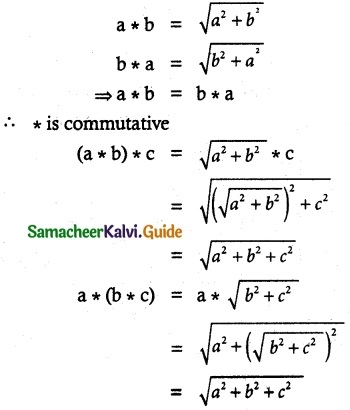
∴ (a * b) * c = a * (b * c)
* is associative
Question 8.
Which one of the following statements has the truth value T?
(a) sin x is an even function.
(b) Every square matrix is non-singular
(c) The product of complex number and its conjugate is purely imaginary
(d) \(\sqrt{5}\) is an irrational number
Solution:
(d) \(\sqrt{5}\) is an irrational number
![]()
Question 9.
Which one of the following statements has truth value F?
(a) Chennai is in India or √2 is an integer.
(b) Chennai is in India or √2 is an irrational number.
(c) Chennai is in China or √2 is an integer.
(d) Chennai is in China or √2 is an irrational number.
Solution:
(c) Chennai is in China or √2 is an integer.
Question 10.
If a compound statement involves 3 simple statements, then the number of rows in the truth table is ……….
(a) 9
(b) 8
(c) 6
(d) 3
Solution:
(b) 8
Hint:
(i.e.) 23 = 8
![]()
Question 11.
Which one is the inverse of the statement (p v q) → (p ∧ q)?
(a) (p ∧ q) → (p v q)
(b) ¬(p v q) → (p ∧ q)
(c) (¬P v ¬q) → (¬p ∧ ¬q)
(d) (¬p ∧ ¬q) → (¬p v ¬q)
Solution:
(d) (¬p ∧ ¬q) → (¬p v ¬q)
Hint:
(p v q) → (p ∧ q)
¬(p v q) → ¬(p ∧ q)
(¬P ∧ ¬q) → (¬p v ¬q)
Question 12.
Which one is the contrapositive of the statement (p v q) → r?
(a) ¬r → (¬p ∧ ¬q)
(b) ¬r → (p v q)
(c) r → (p ∧ q)
(d) p → (q v r)
Solution:
(a) ¬r → (¬p ∧ ¬q)
Hint:
(p v q) → r
Contrapositive is ¬r → ¬(p v q)
¬r → (¬p ∧ ¬q)
![]()
Question 13.
The truth table for (p ∧ q) v ¬q is given below
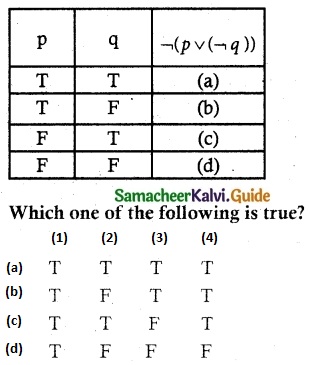
Solution:
(c) (1) T, (2) T, (3) F, (4) T
Hint:
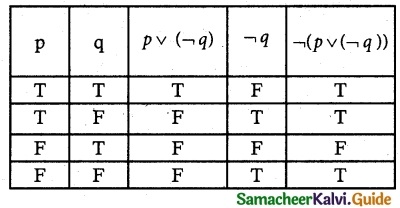
1 = T, 2 = T, 3 = F, 4 = T
Question 14.
In the last column of the truth table for ¬(p v ¬q) the number of final outcomes of the truth value ‘F’ is
(a) 1
(b) 2
(c) 3
(d) 4
Solution:
(c) 3
Hint:
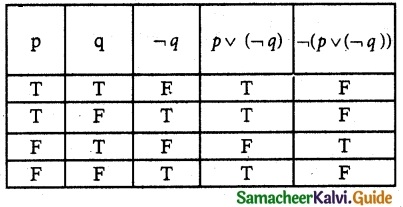
Number of ‘F’ in last column is 3
![]()
Question 15.
Which one of the following is incorrect? For any two propositions p and q, we have
(a) ¬(p v q) ≡ ¬p ∧ ¬q
(b) ¬(p ∧ q) ≡ ¬p v ¬q
(c) ¬(p v q) ≡ ¬p v ¬q
(d) ¬(¬p) ≡ p
Solution:
(c) ¬(p v q) ≡ ¬p v ¬q
Question 16.
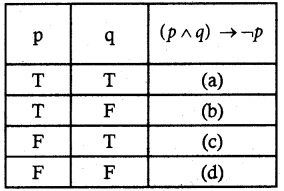
Which one of the following is correct for the truth value of (p ∧ q) → ¬p
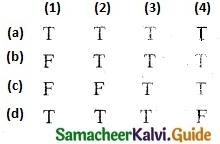
Solution:
(b) (1) F, (2) T, (3) T, (4) T
Hint:
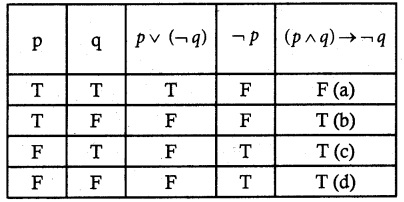
![]()
Question 17.
The dual of ¬(p v q) v [p v(p ∧ ¬r)] is
(a) ¬(p ∧ q) ∧ [p v(p ∧ ¬r)]
(b) (p ∧ q) ∧ [p v(p v ¬r)]
(c) ¬(p ∧ q) ∧ [p ∧ (p ∧ r)]
(d) ¬(p ∧ q) ∧ [p ∧ (p v ¬r)]
Solution:
(d) ¬(p ∧ q) ∧ [p ∧ (p v ¬r)]
Hint:
Dual is obtained by changing ∧ into v and vice versa.
Question 18.
The proposition \(p \wedge(\neg p \vee q)]\) is ……..
(a) a tautology
(b) a contradiction
(c) logically equivalent to \(p \wedge q\)
(d) logically equivalent to \(p \vee q\)
Solution:
(c) logically equivalent to \(p \wedge q\)
![]()
Question 19.
Determine the truth value of each of the following statements:
(a) 4 + 2 = 5 and 6 + 3 = 9
(b) 3 + 2 = 5 and 6 + 1 = 7
(c) 4 + 5 = 9 and 1 + 2 = 4
(d) 3 + 2 = 5 and 4 + 7 = 11
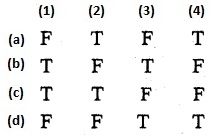
Solution:
(a) (1) F, (2) T, (3) F, (4) T
Hint:
(1) F and T = F
(2) T and T =T
(3) T and F = F
(4) T and T = T
Question 20.
Which one of the following is not true?
(a) Negation of a statement is the statement itself.
(b) If the last column of the truth table contains only T then it is a tautology.
(c) If the last column of its truth table contains only F then it is a contradiction
(d) If p and q are any two statements then p ⟷ q is a tautology.
Solution:
(d) If p and q are any two statements then p ⟷ q is a tautology.
![]()